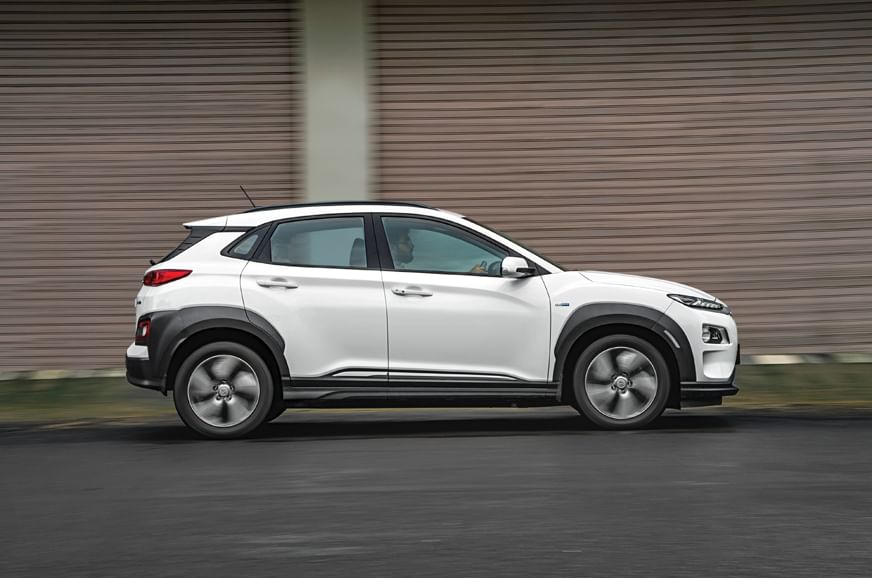2019 Hyundai Kona Electric review, road test
The Kona Electric sure looks interesting. But does it have the real-world performance and range to be considered as an alternative to conventional combustion engine cars?
Published on Sep 29, 2019 10:00:00 AM
1,21,409 Views
Powering the Kona in India is a 136hp electric motor that makes 395Nm of torque. The cabin is
silent even when you push the start button and remains silent when you start driving with a light foot. You have a choice of four drive modes (Eco, Eco+, Comfort and Sport), depending on the way you want to drive. In Comfort mode, the car responds well to a tap on the accelerator and the drive is effortless and smooth. A gentle foot on the accelerator, makes the Kona build speed in a seamless manner. All you need to do for a quick overtake is hit the accelerator pedal a bit harder and the car leaps forward with a surprising surge. This makes closing gaps in traffic easy, and there’s always enough power available. Switch to Sport mode, and responses to accelerator inputs are suddenly sharper. There’s now an instant flow of power when you flex your right foot; and at times, if you are a bit hard on the throttle, you even get a lot of wheel spin. Eco mode is more inclined towards city-driving conditions; and although the accelerator inputs are slightly dull, it still provides enough power to drive smoothly. Long-pressing the drive mode button engages Eco+, the most energy-efficient mode where the Kona’s top speed is limited to 90kph and the climate control is switched off (it can be switched on manually).

So, how fast exactly is the Kona? When we put it through our standard test, the amount of torque available right from the moment you floor the accelerator is too much for the tyres to handle and creates a lot of wheel spin. Despite this, the EV still tested a very respectable 0-100kph time. However, with traction control switched on, the torque is put down on the road in a clean manner, which brought out an even better time of 9.09sec. Impressive.
Like most electric vehicles, the Kona also uses regenerative braking. Energy harnessed from slowing down is stored to the battery. This feels similar to engine braking in a regular car, where the car starts to slow down when you lift your foot off the accelerator. The Kona additionally provides three levels of regeneration via paddleshifters on the steering wheel. However, in the maximum regeneration (level 3), the car’s deceleration is so strong that it feels like the brakes have been applied suddenly. This needs some time getting used to. Level 1 and 2 are more comfortable in the sense that they decelerate in a similar manner as most petrol or diesel cars. There’s a level 0 as well, for no regeneration. Holding on to the left paddleshifter also brings the car to a halt, allowing you to drive the car with just one pedal.
Charging and range
One of the most important aspects of electric vehicles is charging, and Hyundai has done its part to keep you covered. On the purchase of a vehicle, you are provided with a 2.8kW portable AC charger that you can plug into a normal three-pin wall socket (16A). This takes around 19hr to charge the car from 0-100 percent. You are also provided with a 7.2kW wall-mounted AC charger that will be installed at a location of your choice (home or office) and takes 6hr 10min for a full charge. If you want an extra wall box charger, you can get one by paying Rs 80,000. Hyundai is working with Indian Oil Corporation to set up DC fast chargers at different locations across the country. These 50kW DC fast chargers use CCS Type 2 connectors and can charge your car from 0 to 80 percent in less than an hour. For using some of the electric chargers in malls, you will need to buy a type 2 charging cable with a male and female plug on either side. As of now, Hyundai isn’t providing these as part of its package, so you will need to buy it from third-party retailers or online portals.
The Kona has been tested by ARAI under their standard test conditions and they claim it has a range of 452km. This is a bit unrealistic, and under real-life conditions and our city driving cycle, at an average speed of 17kph, the Kona delivered a maximum range of 324km. On our highway test cycle, driving at same speeds as we do on petrol and diesel cars, it gave a range of just 295km – which is lesser than in the city.
This is the reverse of what usually happens with petrol- or diesel-powered cars, and the reason for this is the regenerative brake feature. There is very little regeneration happening on a largely steady state highway run. What also helps the combustion-engine-powered cars is their gearing, which is often ideally suited to highway speeds. Do note that the car was in Eco mode with regeneration at level 3, but the climate control was switched on all the way, as it should be. So, it’s not difficult to get a range of close to the 250-300km mark, depending on how you drive and how much regeneration you can tolerate.
Hyundai Cars
Related Videos
Copyright (c) Autocar India. All rights reserved.


